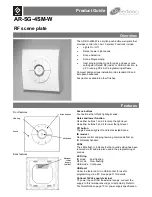DRAFT
DRAFT DRAFT DR
DRAFT DRAFT DRAFT
D
RAF
DRAFT DRAFT DRA
FT D
RAFT DR
AFT D
DRA
FT DRAFT DRAFT
D
RAFT
DRAFT
D
RAFT
DRA
UM10601
All information provided in this document is subject to legal disclaimers.
© NXP B.V. 2012. All rights reserved.
Preliminary user manual
Rev. 1.0 — 7 November 2012
171 of 313
NXP Semiconductors
UM10601
Chapter 15: LPC800 USART0/1/2
15.6.1 USART Configuration register
The CFG register contains communication and mode settings for aspects of the USART
that would normally be configured once in an application.
Remark:
If software needs to change configuration values, the following sequence should
be used: 1) Make sure the USART is not currently sending or receiving data. 2) Disable
the USART by writing a 0 to the Enable bit (0 may be written to the entire register). 3)
Write the new configuration value, with the ENABLE bit set to 1.
Table 158. USART Configuration register (CFG, address 0x4006 4000 (USART0), 0x4006 8000
(USART1), 0x4006 C000 (USART2)) bit description
Bit
Symbol
Value Description
Reset
Value
0
ENABLE
USART Enable.
0
0
Disabled. The USART is disabled and the internal state
machine and counters are reset. While Enable = 0, all
USART interrupts are disabled. When Enable is set again,
CFG and most other control bits remain unchanged. For
instance, when re-enabled, the USART will immediately
generate a TxRdy interrupt if enabled because the
transmitter has been reset and is therefore available.
1
Enabled. The USART is enabled for operation.
1
-
Reserved. Read value is undefined, only zero should be
written.
NA
3:2
DATALEN
Selects the data size for the USART.
00
0x0
7 bit Data length.
0x1
8 bit Data length.
0x2
9 bit data length. The 9th bit is commonly used for
addressing in multidrop mode. See the ADDRDET bit in the
CTRL register.
0x3
Reserved.
5:4
PARITYSEL
Selects what type of parity is used by the USART.
00
0x0
No parity.
0x1
Reserved.
0x2
Even parity. Adds a bit to each character such that the
number of 1s in a transmitted character is even, and the
number of 1s in a received character is expected to be even.
0x3
Odd parity. Adds a bit to each character such that the
number of 1s in a transmitted character is odd, and the
number of 1s in a received character is expected to be odd.
6
STOPLEN
Number of stop bits appended to transmitted data. Only a
single stop bit is required for received data.
0
0
1 stop bit.
1
2 stop bits. This setting should only be used for
asynchronous communication.
7
-
Reserved. Only write 0 to this bit.
8
-
Reserved. Read value is undefined, only zero should be
written.
NA


















